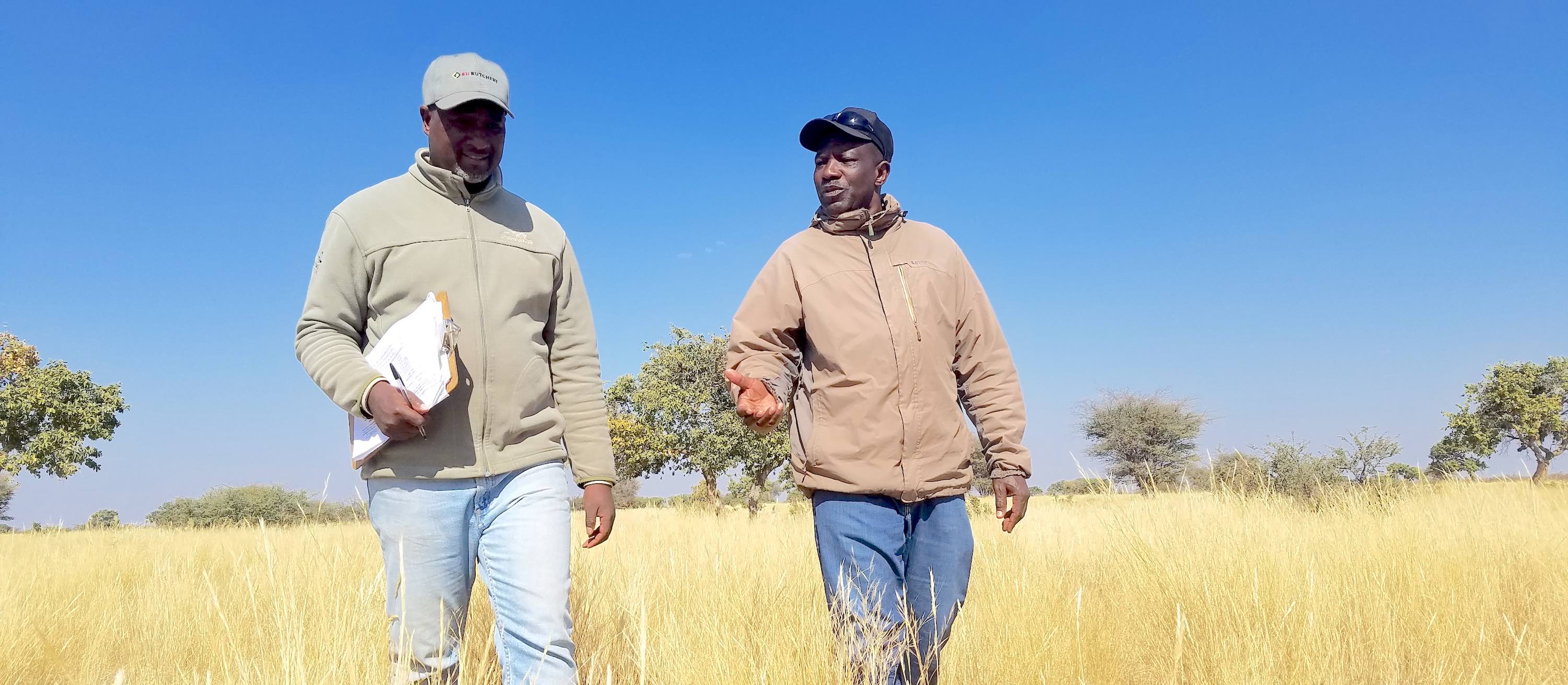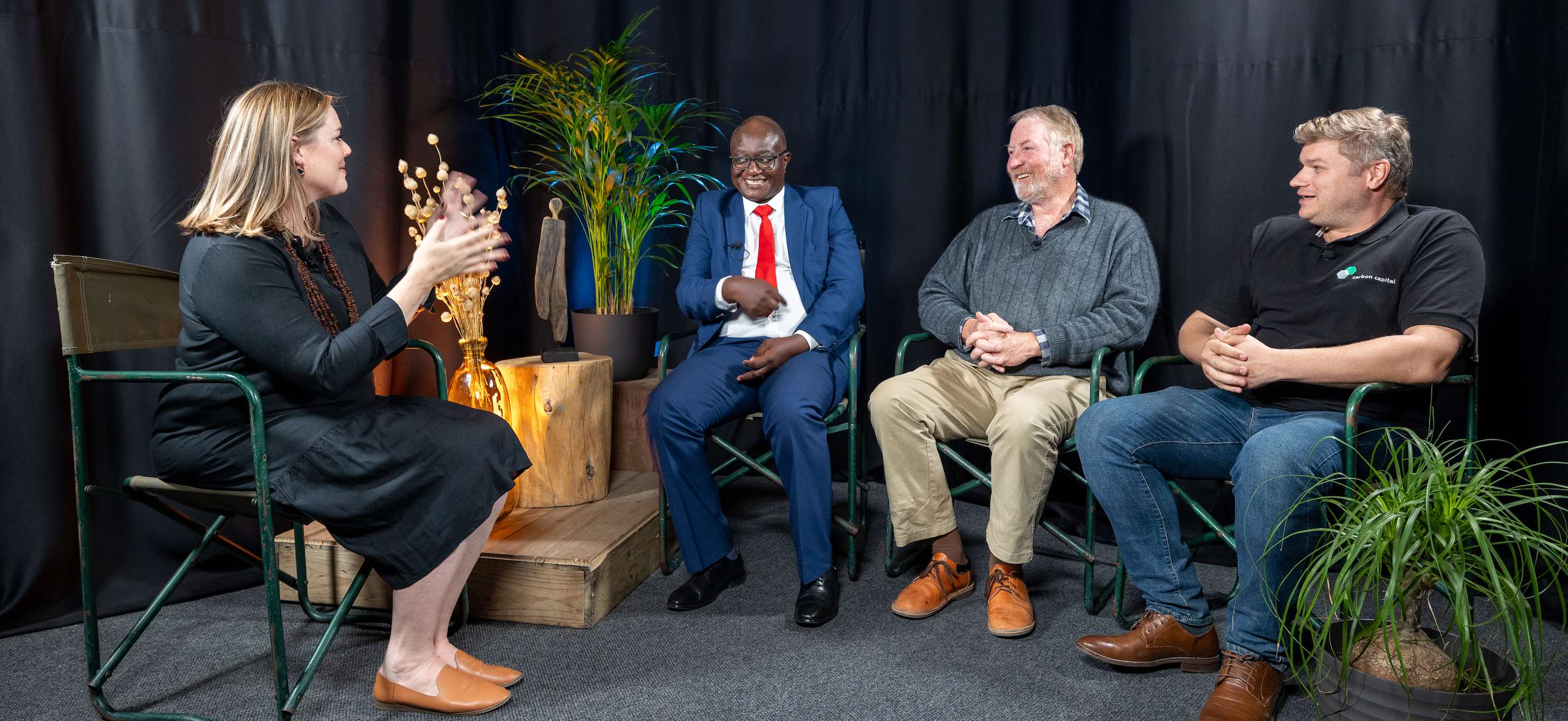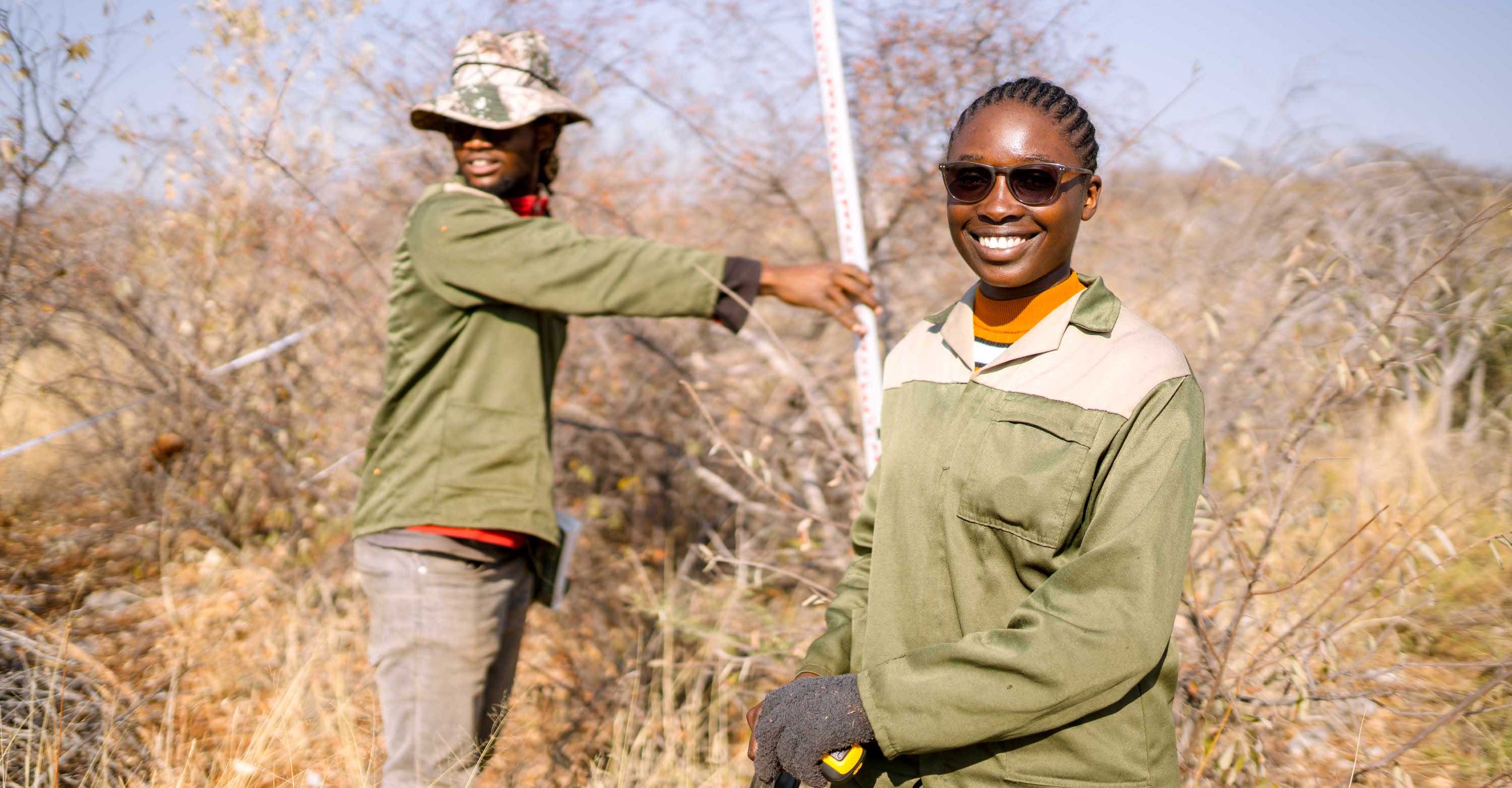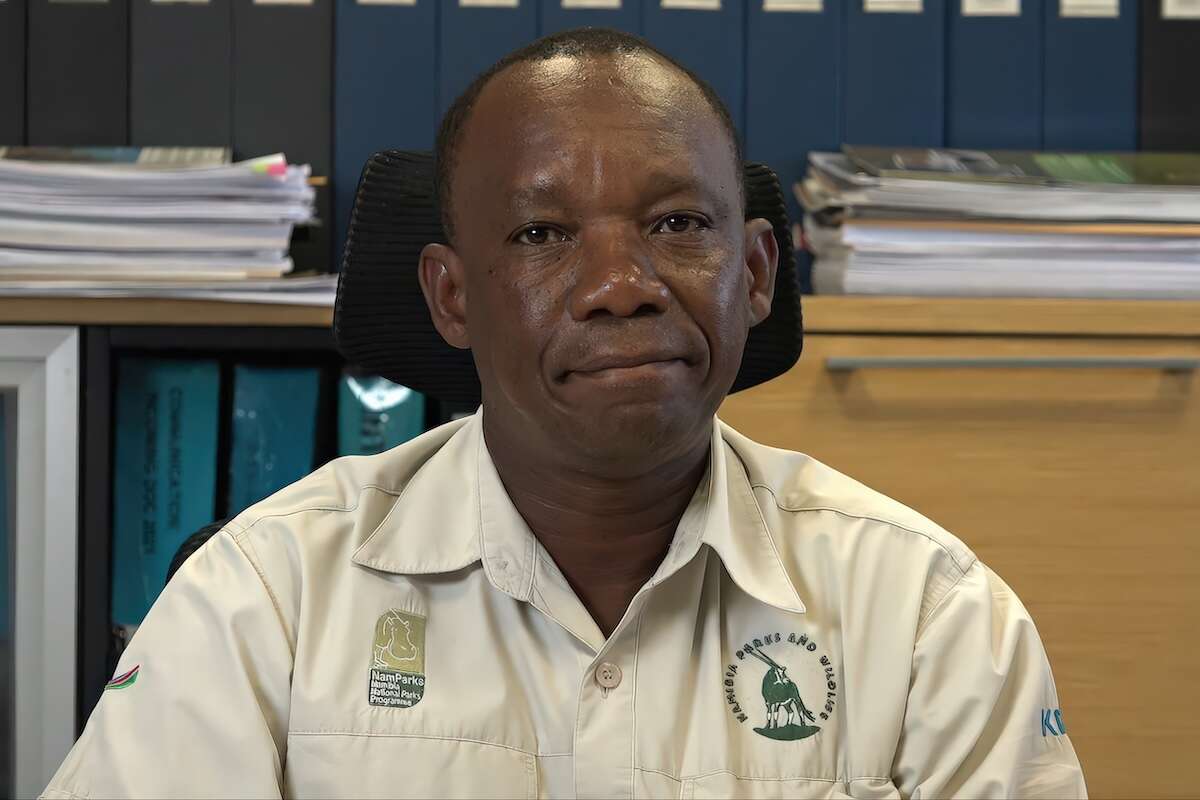
The story of Namibian bush: Turning problems into opportunities
6th November 2023
6th November 2023
An estimated 45 million hectares of Namibia are considered ‘bush encroached’: local bush species have turned once open savannah into thicket. Bush encroachment reduces grass growth, biodiversity and the water-holding capacity of the land, posing a problem for farming and conservation alike. Counter-intuitively, the bush also provides a huge opportunity – farmers looking to restore their rangelands can generate economic returns by joining the dynamic bush biomass industry.
Biomass is organic matter that can be used as a source of energy or fuel. Its uses also extend to animal feed or natural soil fertiliser. Namibia’s bush-encroached rangelands host an estimated 1.5 billion tonnes of standing woody biomass, of which an estimated 30% could be harvested sustainably. These estimates do not consider the annual expansion in bush-encroached areas or the regrowth in harvested areas. Regrowth of woody biomass is estimated at more than 10 million tonnes annually. Only two million tonnes of biomass are currently removed per year, mainly for charcoal and firewood.
Much more bush can be harvested in Namibia without depleting the resource, while at the same time helping to regenerate rangelands and improve their productivity. For decades, farmers have been fighting bush to bring back grasses to their rangeland. It is a complicated, complex and often costly struggle. Sickle bush and blackthorn are particularly aggressive. You need to handle these species very carefully and definitely need aftercare
, says researcher Richard Kamukuenjandje. Without aftercare, the regrowth can be aggressive and worsen the original problem over a much shorter period of time. Tapping into the biomass industry can facilitate restoration of degraded land by increasing farming income streams and allowing for improved rangeland management to take place. This will consequently create more jobs, especially in rural areas.
Recognising this opportunity, private stakeholders are buying into the bush business, and government agencies are providing support for this new industry. Michael Humavindu, Deputy Executive Director in the Ministry of Industrialisation and Trade, says that Namibia now sees the ‘bush problem’ in a more positive light, It is an enabler bush: for industrialisation, for job creation, for environmental sustainability and also to ensure that we have an ecological carbon sink.

As Chris Brown from the Namibian Chamber of Environment (NCE) explains: Bush biomass is carbon neutral when managed sustainably. That gives us a very strong competitive advantage in terms of current global energy requirements. Eurocentric rangeland management practices have resulted in this bush encroachment. What we are focusing on now is restoring rangelands to their pre-damaged condition.
In terms of development, it is strategically significant that biomass is intrinsically decentralised
, as Colin Lindeque, Managing Director of Carbon Capital, puts it. We need to ensure that people do not lose all economic opportunities in the rural areas. Our urban areas cannot sustain the entire Namibian population. The biomass industry has a critical role to play in the economic development of the country
, Lindeque says.
Namibian researchers, conservationists, government ministries and private sector interests such as those quoted above are interested in exploring how we can expand the biomass industry in Namibia while maintaining the highest standards of environmental sustainability and social responsibility. Namibia Nature Foundation and NCE have created the National Dialogue Platform on Bush Resources to take these conversations further and raise broader awareness of the potential of the biomass industry to drive sustainable development.
Some of the key questions the Dialogue Platform tackles include: how can we maximise the economic returns from our biomass? How do we regulate this new industry and maintain standards? How do we market our biomass to the world as a win-win for the environment and development? How can we go beyond primary production and use biomass to create more value?

Maximising returns through exports
Considering the huge amount of biomass available for harvest, Namibia’s domestic market is tiny and local buying power is generally insufficient to support the biomass industry on its own. Furthermore, in most cases, higher prices can be realised on export markets. It's important for us to get the best value possible for our resources and sometimes export markets allow that
, Colin Lindeque points out.
Export markets not only realise higher prices, they often also demand high ecological and social standards from producers. European consumers are especially concerned that the products they purchase must be produced as sustainably and as ethically as possible, for which they are prepared to pay a premium. Standards such as the Forest Stewardship Council (FSC) for charcoal, for example, raise the bar in harvesting practice and socioeconomic responsibility in Namibia and help set Namibian charcoal apart from other less sustainable alternatives.
Namibia’s certified area has boomed over the past years, mostly through FSC certification. Namibia became the first country in Africa to obtain an FSC Group Chain of Custody certificate, with 11 different organisations certified. The group scheme provides local processors with an opportunity to join the FSC value chain at an affordable cost. Consequently, FSC certification in Namibia has grown by over 500% in the past four years. In 2022, 1.8 million hectares of land in Namibia were FSC certified.

Beyond firewood and charcoal: opportunities to expand the market
The main use of Namibian bush is currently charcoal and firewood. Some farmers are using bush as animal feed. Biomass experts are now identifying a next generation of products
.
One of the most promising ideas for both local and export markets is to use biomass to generate electricity in power plants that are designed for this kind of fuel, rather than using fossil fuels. I think we have an opportunity to revolutionise and modernise our energy sector locally
, Colin Lindeque points out. 50% of Namibians still rely on firewood as their primary energy source and that's something we need to change.
NamPower, Namibia’s national power utility, is planning to generate 40 MW of electricity with bush-based biomass. Smaller-scale technologies could support decentralised electrification. Some of the large industrial energy users in the country have also made the switch from fossil fuels to renewable biomass for thermal energy.
A project known as SteamBioAfrica, funded with an EU grant, uses superheated steam to upgrade bush biomass into a more coal-like alternative that is cleaner-burning and easier to process, handle and store than raw biomass. The resulting torrefied (superheated) biofuel can be used as a renewable coal alternative, a clean-burning domestic fuel alternative or an intermediary product for the further production of synthetic liquid fuels. The demonstration plant is located at the Cheetah Conservation Fund's Biomass Technology Demonstration Centre and will be used to further test and refine the technology before it is launched commercially.
Another biomass product with multiple possible uses is known as biochar. It is a form of charcoal produced by burning biomass at extremely high temperatures, usually in an oxygen-free environment. Biochar must meet specific chemical requirements in order to be called biochar. Soil structure and productivity can be improved by biochar when following best practices. The addition of a stable carbon into soil also creates opportunities for generating carbon credits. Namibia generally has poor soils and little rainfall. Enriching agricultural soils with properly prepared biochar is expected to increase agricultural productivity as well as food security for marginalised subsistence farmers. Biochar also has applications for soil remediation, water treatment and absorption of pollutants, and can therefore play an important role in the local mining and water sectors.
Developers in Namibia are looking into producing alternative building materials by combining the recycling and biomass sectors. Wood-plastic composites using bush biomass and recycled plastics make durable, high value materials for the construction industry. Industry leaders and researchers are still adding to these new ideas and testing production methods and markets to find profitable ways of using bush biomass.
Research and communication are needed to grow the industry
More research is needed to fully explore the potential of harvesting bush to restore rangelands, capture carbon and conserve biodiversity. Currently, we don’t have scientific consensus on whether bush harvesting decreases or increases soil organic carbon
, says Evert Strydom, Programme Director at the Perivoli Rangeland Institute.
Sequestering carbon in the soil is seen as a way to mitigate global climate change by reducing atmospheric carbon dioxide. Small increases of soil organic carbon over very large areas will significantly reduce atmospheric carbon dioxide. To learn more about the impact of bush control and biomass utilisation on carbon levels, research institutions are working with industry, civil society and government to refine the Namibian soil research methodology and set up a farmer research network.
While Namibian stakeholders are positive about the biomass industry because they understand the issue of bush encroachment, external stakeholders who are not familiar with the Namibian situation may see it as deforestation or environmental degradation. The one constraint that we do have is that not everyone everywhere understands this
, says Chris Brown. That is one of our challenges, to get information out to the world to explain that this is actually a rangeland restoration project, not a deforestation project. When people hear about bush being cut, they automatically assume that we are involved in deforestation. To get the message across, that this is actually rangeland restoration, not deforestation, is quite a difficult thing.
The bush biomass industry is only just beginning in Namibia and it will take many different sectors of society to realise its full potential. Ultimately, Namibia is looking for a 'triple win' situation where rangelands are restored to improve agricultural productivity, biodiversity is conserved and green energy production encouraged, and the rural economy is developed to create jobs and business opportunities for entrepreneurs. Over time, the bush thickets that dominate the central areas of Namibia will be viewed as an economic opportunity rather than just an ecological problem.
For articles on similar topics, please click one of the following options:
For more great articles from Conservation Namibia see below...
Conservation Namibia brought to you by:
We use cookies to monitor site usage and to help improve it. See our Privacy Policy for details. By continuing to use the site, you acknowledge acceptance of our policy.











